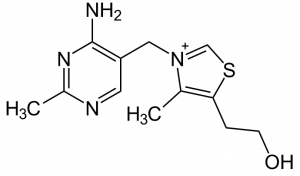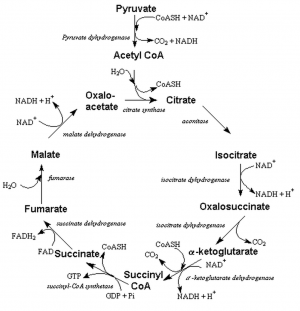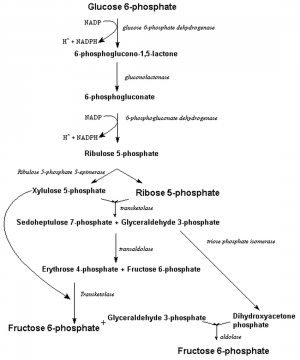Thiamine (vitamin B1)
Last edited on : 22/09/2024
Thiamine (vitamin B1) is the first compound recognized as a vitamin, an essential substance for metabolism that the body relies on from external sources. It is necessary for the proper functioning of the neurological, muscular (including cardiac), digestive systems, and carbohydrate metabolism in humans. Deficiency situations are common (most often in the context of chronic alcoholism in developed countries) and can lead to severe pathologies.
Nature and Chemical Properties

Thiamine is a water-soluble molecule and is insoluble in acetone. It is thermolabile (denatures at 100°C in aqueous and alkaline environments). It appears as crystals under standard conditions.
It consists of a pyrimidine ring and a thiazole ring. Available as hydrochloride or mononitrate, its molecular formula is C₁₂H₁₇N₄OS⁺.
Elements of Pathophysiology


The human body is unable to produce thiamine and depends on dietary intake. It is stored in only very small amounts by the muscles, nervous system, and liver. In the absence of sufficient external intake, these reserves are depleted in 2 to 3 weeks. Thiamine is the precursor of two bioactive forms necessary for the proper functioning of several metabolic pathways:
- Thiamine pyrophosphate (or thiamine diphosphate, TPP), which is involved in:
- Carbohydrate metabolism and energy reserve production:
- Krebs cycle: TPP catalyzes the oxidative decarboxylations of pyruvate, contributing to the production of acetyl-CoA, and alpha-ketoglutarate, contributing to the formation of succinyl-CoA.
- Pentose phosphate pathway: TPP is also the coenzyme of transketolase, catalyzing the production of fructose-6-phosphate.
- Degradation of pyruvate (see Krebs cycle), whose accumulation leads to the overproduction of lactates (toxic to all cells, but particularly to neurons and glial cells).
- The oxidative decarboxylation of pyruvate (see Krebs cycle) is also a necessary step in the formation of acetylcholine (a neurotransmitter), and that of alpha-ketoglutarate in the formation of gamma-aminobutyric acid (GABA, a neurotransmitter).
- Carbohydrate metabolism and energy reserve production:
- Thiamine triphosphate, whose role is still poorly understood. It is thought to be involved in cell signaling processes and neurotransmission.
Magnesium is an essential cofactor for TPP activity.
A deficiency in TPP or its cofactors therefore leads to cellular distress (energy deficiency), particularly for the nervous system and cardiac muscle (the tissues with the highest energy demand). Some authors suggest a possible individual genetic susceptibility (enzymatic abnormalities in the aforementioned pathways).
Such a deficiency can occur in different situations (isolated or combined):
- Insufficient dietary intake of thiamine
- Impaired intestinal absorption of thiamine
- Impaired phosphorylation of thiamine to TPP
- Physiological or pathological hypermetabolic and hypercatabolic states (overconsumption of TPP)
- Increased urinary excretion of thiamine
- Presence of compounds neutralizing thiamine (thiaminases)
- Severe hypomagnesemia
Dietary Sources and Daily Requirements
The main dietary sources of thiamine are: beef, yeast, beans, lentils, nuts, oats, unrefined rice, seeds, wheat and whole grains, oranges, milk and dairy products, eggs.
The daily requirements for adults under normal conditions are estimated to be 0.5 to 2 mg/day.
Clinical Implications
Etiology of Thiamine Deficiency and Metabolism Disorders
- In developing countries: Undernutrition and malnutrition are considered almost exclusive causes. However, epidemiological data are limited.
- In developed countries:
- Chronic alcoholism is the predominant cause (present in > 50% of cases).
- Possible mechanisms: frequently inadequate dietary intake in alcoholics, impaired intestinal absorption due to the digestive toxicity of alcohol, increased carbohydrate metabolism (which consumes thiamine) due to alcohol, impaired thiamine metabolism (hepatic insufficiency), increased incidence of hypomagnesemia, and other promoting conditions.
- Various (rare causes taken individually but accounting for nearly 50% of cases overall):
- Restrictive or unbalanced diets, anorexia, pregnancy and breastfeeding, parenteral nutrition without supplementation, malnutrition, gastrointestinal surgery, cancers, transplants, dialysis, acquired immunodeficiency syndromes, persistent vomiting or diarrhea, hepatic insufficiency, fevers, and prolonged hypercatabolic or hypermetabolic conditions (hyperthyroidism, etc.), inappropriate infusions, severe hypomagnesemia, polyuric and diuretic syndromes, genetic syndromes (thiamine-responsive megaloblastic anemia, thiamine-related metabolic dysfunction syndrome), etc.
- These etiologies can lead to Wernicke's syndrome and/or beriberi alone, combined, or in the context of chronic alcoholism.
- Chronic alcoholism is the predominant cause (present in > 50% of cases).
Pathological Implications
The pathological consequences of thiamine deficiencies and metabolism disorders are artificially (for historical reasons) divided into three syndromes covered in specific chapters:
Some pathological conditions leading to thiamine deficiencies also lead to their own complications. Moreover, no known toxicity exists from an excess of thiamine.
Prevention of Deficiencies
Given the poor therapeutic response rates of Wernicke's syndrome and beriberi, their significant morbidity and mortality, their prevalence, and the relative safety of vitamin supplementation, supplementation should be systematically initiated for:
- Long-term PO supplementation (e.g., thiamine 300 mg/day): for all chronic alcoholics and malnourished patients, those with malabsorption, who have undergone bariatric surgery, etc.
- IV supplementation (500 to 1500 mg/day IV for 3 to 5 days) before switching to enteral administration:
- Any chronic alcoholic, malnourished, or malabsorptive patient requiring infusion or refeeding. Consideration should be given based on the situation for certain at-risk patients such as those undergoing cancer treatment.
- Any patient who is confused or has balance disturbances of (sub)acute onset without an obvious explanation.
- Any hospitalized patient in a prolonged hypermetabolic or hypercatabolic state (particularly in intensive care).
However, as often, most preventive measures extend beyond the strictly medical framework and fall within the realm of public health policy: combating alcoholism, malnutrition, poverty, and inappropriate diets. It is up to policymakers to take responsibility.
Toxicity
Oral thiamine has no known toxicity at usual doses. Intravenously, anaphylactic reactions are exceptionally reported. At high doses or in at-risk patients, it may disrupt glucose balance.
Routine Clinical Testing
The currently available techniques for measuring circulating thiamine are either too unreliable (requiring strict sampling and transport conditions, as thiamine degrades rapidly) or too expensive, and are not used in routine clinical practice. Diagnosis of deficiency is primarily based on clinical assessment and exclusion of differential diagnoses. However, testing can be discussed with certain laboratories for studies or very specific clinical situations.
Measurement of pyruvate metabolites is less specific but feasible in routine practice and can provide a guiding element. In cases of impaired pyruvate decarboxylation, the following are observed: lactic acidosis, increased pyruvate, normal or decreased lactate/pyruvate ratio, increased alpha-ketoglutarate, increased aluminum.
Bibliography
Guilland JC, Vitamines hydrosolubles (I). Thiamine, riboflavine, niacine, acide pantothénique, vitamine B6 et biotine, Encyclopédie Médico-chirurgicale, Endocrinologie-Nutrition[10-546-A-10], Elsevier, Paris, 2012
Pazirandeh S et al., Overview of water-soluble vitamins, UpTodate, 2018
World Health Organization (WHO) and United Nations High Commissioner for Refugees (UNHCR), Thiamine deficiency and its prevention and control in major emergencies, WHO, 1999

